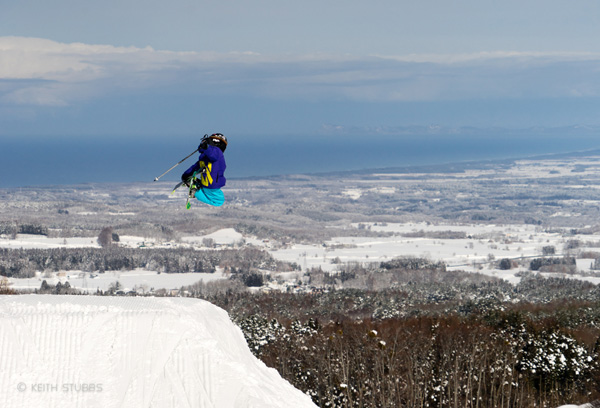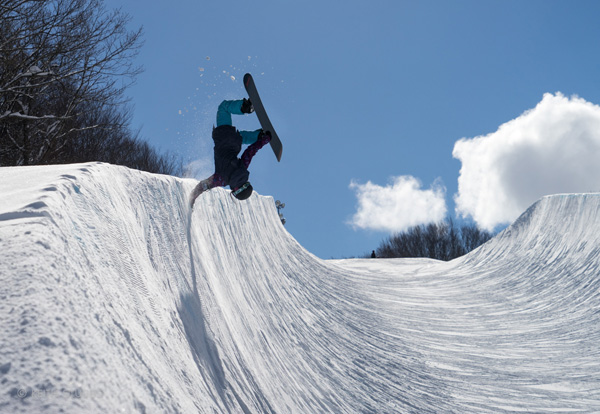Every winter a growing number of powder seekers arrive on Japan’s shores and then head to the mountain in search of the famous bottomless snow falls. Ski resorts have taken notice as more and more are turning their attention to developing off-piste terrain and backcountry access, or attempting to at least.

Up north in Tohoku, Aomori Spring Ski Resort (known as Naqua Shirakami before the new ownership group purchased the complex in 2014) is refusing to follow the powder crowd and going freestyle. Taking a leaf out of Sun Tzu’s book, they may be changing the snow landscape in Japan by building the country’s premier park resort.
The events of 3/11 had grievous effects on a number of ski resorts in Honshu, particularly the Fukushima resorts, leaving a gap in the domestic freestyle skiing and snowboarding market.
Alts Bandai once led the way in park and pipe facilities and played host to Asia’s premier snowboard contest, the Burton Nippon Open (which went on to become the Asian Open Snowboarding Championships in 2009). Needless to say, this event was forced to move from Alts Bandai after the earthquake—even though they still maintain a quality terrain park to this day.
So the door to Japan’s freestyle market is currently wide open, and very few resorts are attempting to walk through it, which is crazy considering the current level of Japanese park and pipe riders.
In steps Aomori Spring. An hour’s drive from both the Shin-Aomori Shinkansen stop and Aomori International Airport, this resort is easier to reach than you might think. The hotel at the base offers all-inclusive packages, with an impressive buffet breakfast and dinner service and a stand-out onsen.
But that’s probably not going to be the motivation for your next trip to the northernmost point of Tohoku.
When the new Korean-American ownership team took over the resort, it knew the effect a well-built park could have. One of the first things they did was inquire about halfpipe cutting machines and the best pipe builders. It didn’t take long for the search to lead them to John Melville from Development Snowparks.
John is a Kiwi with a considerable history in the industry. Having designed his Global Cutter pipe machine in 2006 (patented in 2010), his company, along with his new creation, was contracted for the 2014 Winter Olympics in Sochi. He’s since gone on to design and build parks around the globe as well as work on some of the biggest events and projects in the free-ski and snowboard world. Now he’s in Aomori.
The Kiwi Connection
The 2016-2017 winter in Aomori Spring has seen numerous faces appear on the resort’s guest list. New Zealand pro snowboarder Will Jackways, NZ Snowboarder Magazine, myself, a NZ snowboard coach and some other riders, made Aomori a must stop on this year’s Japan agenda.
Olympic pipe rider Katie Tsuyuki (Canadian-Japanese) has been in and out of Aomori a number of times to train for the South Korea World Cup test event and to run coaching camps in partnership with the resort.
The blonde-haired, already-sponsored 9-year-old super twins, Fin (free-ski) and Cam (snowboard) Melville-Ives have chosen Aomori Spring as their northern hemisphere training ground.
Elijah Teter (ex-US Snowboard Team athlete-turned top coach, currently working with Japan’s top pipe rider Ayumu Hirano) and the Method4Life snowboarding academy made a stop here at the end of March too. The list goes on.
You might be wondering how this comes about for a relatively unknown resort in one of Japan’s more out-ofthe- way prefectures. It’s the Kiwi connection. John Melville spends his Southern Hemisphere winters based at Cardrona Alpine Resort in Wanaka, New Zealand, renowned for its huge terrain park and two halfpipes.
It’s home to the Melville-Ives twins and Jackways and is the training ground for Tsuyuki and many of Elijah’s athletes. Kiwis and fondly adopted Kiwis are helping to put Aomori Spring on the freestyle radar internationally.

Park Terrain
From the top of a high-speed quad chairlift, located next to the main car park, access to both the park and pipe is a breeze. The park begins with three flawlessly sculpted small jumps alongside some easy ride-on boxes, ideal for those getting in the air or sliding on metal for the first time. This flows into a smooth step-up-like tabletop—the perfect next step for intermediate park skiers and riders.
Further down you have a series of three larger jumps, gradually increasing in size from 10 to 15 meters and aimed at more advanced park riders. The bottom half of the terrain park includes a few different sized jumps, a number of hips and transfer jumps, more rails and boxes with a street-style setup at the bottom.
It’s an impressive collection of features that allows skiers and snowboarders to put together a total of 13 jumps or rails/boxes in a line of their choosing. That’s not all. The icing on the cake for this park—and we’re talking thick strawberry-infused icing with lumps of soft caramel—is the behemoth seven-meter halfpipe. This bad boy is unreal. It is one of just three halfpipes of this size in Japan, the others belonging to Sapporo Bankei and Takasu Snowpark.
While the sheer size of the walls are certainly daunting at first, the progressive shape (thanks to John’s amazing piece of engineering) is as safe as you can get and probably easier to ride than a small pipe, as you can adjust to the speed.
The walls are so smoothly shaped, you feel as if you’re levitating on a roller coaster. No whippy transitions. No over-vert walls. This is the real deal and the best part of the whole set-up is it is open at night.
What’s next for Aomori Spring?
The current array of features in the Aomori Spring park is impressive but is only about half of what they are planning. Over the next few years, prepare to see this become the park of all Japanese parks. It’s currently being scouted as a pre-Olympic training ground before next year’s winter games in South Korea. If national teams start booking, the park will reach its full capabilities very quickly.
The plans are huge, and they don’t stop with the park and pipe. The motivated resort owners openly discuss their vision for the unobstructed base area that has plenty of room to grow.
Condominiums, backpacker-style capsule hotels and a comprehensive indoor sports facility all feature in the plans. They also hope to create a village-style precinct with leases available for private businesses in which to operate, unlike many Japanese resorts.
The new proprietors think very differently from past owners. They understand, to create a vibrant ski village atmosphere, you need external influences as much you do your own. Attracting motivated small businesses that can bring a creative flair is the key.
Bar and cafe owners, restaurateurs, retailers and beauty treatment specialists: everything a ski village needs to keep everyone entertained and happy during their winter vacation.




